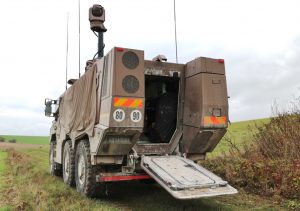
French Army: first training deployment for the VBMR Griffon VOA artillery observation vehicle
The first training deployment in a major field exercise of the Griffon VOA (Artillery Observation Vehicle) artillery observation vehicle allowed getting first-hand impressions on how the new asset entering in service with the Armée de Terre indirect fire units allows improving effectiveness

Intended to replace the VAB 4×4 armoured personnel carrier in French Army service the VBMR (Multi Role Armored Vehicle) Griffon, produced by the industrial team formed by Nexter, Arquus and Thales, has already largely entered service within the Armée de Terre as a troop transport vehicle. Like its predecessor, it is gradually evolved in a series of versions according to the needs of the different Army specialties and within the precise framework requested by the DGA (Directorate General of Armaments).

The BIA 23 combined arms field exercise took place in open terrain from November 26 to December 3, 2023 the military camps of the Champagne region; it involved the 6th Light Armoured Brigade, equipped with Scorpion vehicles, and the 3rd RAMA (Marine Artillery Regiment), the Brigade indirect fire combat support unit, had the opportunity to deploy for the first time on such an exercise one of the 11 Griffon VOA received in October 2023 by the Armée de Terre.
The vehicle, validated at the end of last summer, has a command post layout, with four military on board consisting of the driver, the commander who also manages the remotely operated turret, and two non-commissioned officers, respectively the observer and the navigator/radio operator.

These two personnel face the two computer analysis and observation consoles in the transverse direction of travel. (PHOTO N° 3) In addition, two rear seats can be added to carry infantrymen or other artillery specialists, for example a drone operator.
The main tool of the VOA consists of the sensors suite installed on top the 4.50 metres telescopic mast. This includes five systems, a laser rangefinder, a laser pointer, a laser designator, and above all a TV day channel and a thermal camera providing the night channel.

Their images can be combined in low light conditions, especially during short winter days, at dawn or dusk. Cameras allow observation and target acquisition range of 10 to 20 km. Should the sensor suite be the subject of malfunctions, multifunction binoculars available on board allow to continue the mission in degraded mode.
The vehicle can move at low speed with the mast partially or even completely deployed, but only on terrain free of any obstacles . In the event of a blockage or failure a degraded mode is provided to manual retract the mast using a crank system.
“A MURIN surveillance radar can be easily added on board as the space and connectivity are already planned. It will help us visualize targets complementing the mast-mounted sensors suite,” the observer non-commissioned officer added. This radar is already in service with target acquisition batteries part of artillery regiments.

The lieutenant in charge of fires coordination within the acquisition and surveillance battery explained to EDR On-Line: “The acquisition can then be coupled with laser telemetry sent by the optronic gimbal, allowing to transmitting target coordinates to the higher echelon. These information are valuable to us, and via my post on board my PVP armoured utility vehicle I can switch them either to a command post, a CAESAR self-propelled howitzers battery, or a heavy mortars unit.”
The size of the Griffon VOA compared to that of its VAB-based predecessor, which featured a very low silhouette, remains an issue. However its huge visual signature is largely compensated by the extension of the discreet mast, which makes it easier for the VBMR to take advantage of terrain obstacles to better protect and hide itself, remaining at considerable distance from enemy observation.
Info-valorization of data allows faster communication and sharing of information and tactical data, with augmented reality, which on the one hand reduces possible accidental friendly fire, while on the other it shortens the sensor to shooter cycle, allowing earlier firing orders to improve effectiveness against the enemy. Positive feedback from the field should guarantee a certain future for the 106 other GRIFFON VOA awaited by the Army within 2035.
Photos by J. Hadacek



